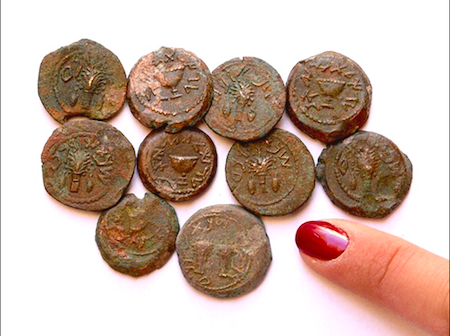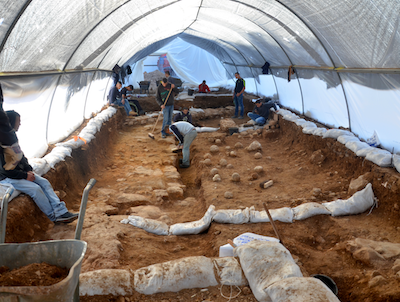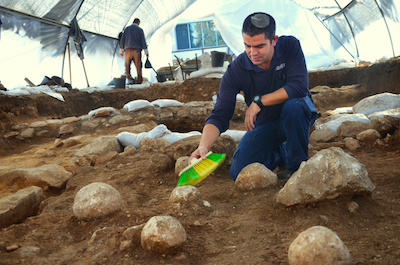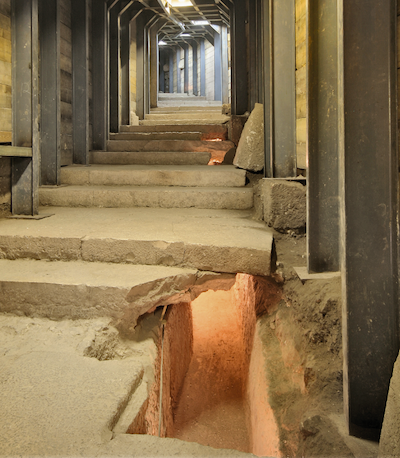The last decades yielded many new findings from the First Jewish Revolt in Jerusalem: rebels’ coins of “year 4”, water systems installed by the defenders, broken flagstones that testify for Romans hunting Jewish refugees, and even a battle scene that recorded the use of ballistae. Today we know much more than we did thirty years ago. It is the time to raise new questions on the correlation between Josephus and archaeology.
By David Gurevich
Post-Doctoral Fellow, Institute of Archaeology, Hebrew University of Jerusalem;
Post-Doctoral Fellow, Department of Land of Israel Studies and Archaeology, Bar-Ilan University
Research Fellow, The Nelson Glueck School of Biblical Archaeology, Hebrew Union College Jerusalem
May 2018
At the end of March 2018, Dr. Eilat Mazar of the Hebrew University announced the discovery of dozens of bronze coins of the First Jewish Revolt (66 –70 CE) in her Ophel excavations in Jerusalem.[1] Coins of the rebels’ mint are not an unusual finding in Jerusalem. However, a few factors contribute to the interest in her recent discovery.

Excavations. Courtesy of Eilat
Mazar.
First of all, the site of Mazar’s work is located just a few meters away from the Temple Mount. The Temple was the symbol of the rebel’s struggle. [2]Moreover, the coins were found in a cave of dimensions 14 × 7 m, where Mazar detected on the floor only two occupational layers: the earliest from the Hasmonean rule (2nd – 1st centuries BCE), and the later layer represents the Early Roman period (63 BCE–70 CE). This last layer ceased to exist with the destruction of Jerusalem by Romans. At the time of the Revolt, the cavern was used by rebels, perhaps as a hideout or simply as an underground living space. What is even more interesting is that at least a quarter of the bronze coins represent the year 4 of rebels’ mint (69–70 CE).[3] Hence, it constitutes a clear indication that the cave was occupied till the very last stages of the Revolt and then it was abandoned.
Jewish coins of the Great Revolt have received considerable scholarly attention in recent decades.[4] The First Revolt coins were minted in silver (sheqalim) and in bronze (prutot and higher denominations). Most of the coins of the First Revolt were found in Jerusalem and the hill country of Judaea; a few examples have been located in more distant places in Israel. The inscriptions and motifs on the coins are linked to Jerusalem and to the Temple that both had a strong religious and national significance for the rebels’ struggle. On Mazar’s year 4 coins, for instance, the reading is “לגאלת ציון” (“for the redemption of Zion”). The term “Zion” is a synonym widely accepted in the biblical sources for Jerusalem (eg. Pss. 76:3, Zech. 9:9).
The rebels used the paleo-Hebrew script for delivering their message. This ancient script, which was the ‘standard’ script in the era of the First Temple, was not in common use during the later Second Temple period. It was revived on the coins to remind the Jewish fighters of their shared heritage of the past (though it is doubtful how many among the population could actually read the paleo-Hebrew script).
The coinage points to the existence of a leadership that was able to design dies, mint the coins, and introduce them into the circulation. It seems that the coinage was part of the propaganda efforts that aimed to inspire the fighters in their struggle. The counting of Revolt’s years on the coins aimed to announce the new era of the independent political entity that had started in 66 CE.[5] More important is that this leadership could guarantee that the money would be respected as a method of payment—a clear indication for the sovereignty of an independent Jewish entity. However, none of the revolt leaders is mentioned on the coins, probably for the purpose of uniting the ranks. This is contrast to the coins of the later Bar-Kokhba Revolt, struck over sixty years later, which refer to “Simon Prince (Nasi) of Israel” as an authority. This raises some questions.
Josephus, in his work The Jewish War, describes the civil war between the various Jewish factions in Jerusalem during the Revolt. The infighting culminated on the eve of the arrival of the Roman army. The moderate Revolt Government was violently overthrown. Jerusalem came under control of different groups, each one headed by a charismatic leader: Simon bar Giora, John of Giscala and others. The Year 4 coins have been discovered in Jerusalem in the past, but Mazar’s new findings contribute to the sheer number of the known specimen of this type. The coins testify that the rebels’ authorities—whoever those were—put efforts on maintaining an independent fiscal institution till almost the very last stage of the war, even after other regions of the country had been captured and, maybe, after the Roman campaign in Jerusalem had begun.[6] In some way, contrary to the narrative of Josephus, the archaeology seems to demonstrate that the factions found common ground at least on issuing currency of a particular mint. Perhaps, Josephus exaggerated the conflicts between the faction to please his Roman readers?
New Data from the Great Revolt in Jerusalem
The findings in the Ophel join the ‘mosaic’ of recently-obtained data in Jerusalem that sheds some light on the last days of the city in 70 CE.
The water supply. The aqueducts which conveyed water to Jerusalem from the distant Solomon Pools were apparently cut off during the Roman siege. The High-Level Aqueduct was completely dismantled in its final segment near the city.[7] Evidently, the rebels prepared for this possibility in advance by collecting water for the siege. Interesting evidence was recently discovered in an excavation south of the Siloam Pool, headed by Dr. Shlomit Weksler-Bdolah.[8] At the inner side of the city walls of Jerusalem of the Late Second Temple period, she exposed a plastered water reservoir designated to store water conveyed by the Siloam Tunnel. The reservoir presumed to have dimensions of 20 × 15 m, and depth of at least 2.8 m. A single Year 2 coin was discovered in the last phase of its plaster, which means that the reservoir was renewed in the time range between the minting of the coin (67–68 CE) and the Roman devastation (70 CE). A few meters away, Weksler-Bdolah found another reservoir, which was installed inside an earlier tower. It is possible that it was also used in preparation for the siege.

Revolt at the Russian Compound,
Jerusalem. Photo by Yoli Shwartz, IAA.
Courtesy of Kfir Arbiv and IAA.
A battle scene. An extraordinary evidence of a military struggle during the First Revolt was discovered in a salvage excavation in the modern Russian Compound in 2016.[9] The excavators, Dr. Rina Avner and Kfir Arbiv, exposed a wide foundation (width c. 6.7 m), oriented north-south, which they interpreted as a fragment of Jerusalem’s fortification system (Fig. 2). The site yielded findings that testify to a large-scale battle that took place on site: Eighty ballista stones and sling stones were exposed attached to the western side of a wall (Fig. 3). Some of the stones were found shattered. The excavators dated the finds using pottery to the end of the Second Temple period.

sling stones in-situ at
the Russian
Compound
excavations,
Jerusalem. Photo by
Yoli Shwartz, IAA.
Courtesy of Kfir Arbiv
and IAA.
Avner and Arbiv suggested that the foundation is a tower or a forerunner in the Third Wall of Jerusalem.
The search for Josephus’ Third Wall goes back to 1930’. At that time, E.L. Sukenik and L.A. Mayer unearthed a massive wall, c. 445 north of the Ottoman Old City’s Damascus Gate.[10] They believed that they discovered the famous but yet unfound Third Wall, the northern frontier of Jerusalem, mentioned by Josephus (War, 5.147–155). Since then, a few fragments of Sukenik-Mayer's Wall were revealed sporadically north of the Old City, but the complete route of this wall is still unknown. Morever, in the recent decades, Sukenik and Mayer's identification was again challenged by scholars.[11] Among many arguments, the prime difficulty is that this wall simply encapsulates a huge territory, far away from the residential quarters of the city.
Avner and Arbiv, who accepted Sukenik-Mayer’s hypothesis, postulated that at the Russian Compound they unearthed a battle scene in front of this wall. Furthermore, they suggested that their discovery constitutes a final proof for resolving the question of the Third Wall’s route:
“We believe that our discovery supports the ‘maximalist’ group who identified the ‘Third Wall’ north of the wall of the Old City, and in the same time it refutes the theory of ‘minimalists’ who claimed that the Old City wall preserves the route of the ‘Third Wall’… In this light, it is possible to return to the description in Josephus's writings on the war in Jerusalem, and to investigate whether and how the writings integrate with the findings, and what is the contribution of the new discoveries to our understanding of this battle.”[12]
In my view, even if we accept that the Sukenik-Mayer wall is the Josephus’ Third Wall (which is a sophisticated question by itself), Avner and Arbiv’s link to this wall is uncertain, or even doubtful. The facts are that no fragments of the actual wall were unearthed in their excavation, nor it could be traced outside the excavated area. In addition, their wide foundation could be part of an extra-mural stand-alone structure used by rebels, or even a platform for Roman ballista from where they could launch their assaults on the city.
In any case, the excavation in the Russian Compound revealed a fascinating chapter in the history of the First Revolt that must be further studied.
Drainage hideouts. Some residents of Jerusalem chose to hide as the Roman assault advanced. A testimony for their sad end was unearthed in the City of David by Prof. Ronny Reich and Eli Shukron in 2006–7.[13] Their excavations in the south of the Tyropoeon Valley revealed a fragment of a paved street that, in regular days, served as an important traffic artery of the city: This street ascended from the Pool of Siloam to the area of the Temple Mount. The archaeologists noted on its eastern side a series of deliberately made breaks in the flagstones that led down into the drainage from the surface (Fig. 4). Drainage’s height in this section is quite low, allowing an adult person only to crawl inside. But the real surprise was waiting inside. On the floor of the channel, a few intact cooking pots of 1st century CE were discovered. With these, many pottery shreds and rebels’ coins of years 2, 3, and 4 were found.

paved street as discovered by
Reich and Shukron's
excavation. Photo by Vladimir
Naikhin. Courtesy of City of
David Archives.
The excavators suggested that the findings constitute archaeological evidence for Josephus’ testimony of rebels hiding in subterranean passages (War, 5.370). However, after the battle, the Romans searched for the survivors underground:
“For when all who showed themselves had been either slain or made prisoners by the Romans, the victor instituted a search for those in the mines, and tearing up the ground, slew all whom they met.” (War, 5.429–430; trans. J. Thackeray).
It is possible that the Romans broke through the flagstones for this purpose. If this is the case, these damaged pavement slabs bear the most dramatic evidence for the last days of Jerusalem. On the other hand, it is also possible that the damage was done by the rebels during the internal violent conflicts between the factions (that are also described by Josephus).
Conclusion
The last decades yielded many new remains in Jerusalem from the time of the First Jewish Revolt against the Romans: coins, water systems, evidences for violent confrontations. Today we know much more than we did thirty years ago. Despite the fact that the available data are still partial, the obtained archaeological record already enables us to raise new questions. Major directions of further research should focus on the assessment of the primary source for the events in Jerusalem—Josephus’ The Jewish War—in light of the new archaeological findings. How credible is Josephus’ testimony? How much weight should we give to Josephus when analyzing the findings from the field? We could also ask questions regarding how we, archaeologists and historians, do our own work. For instance, it would be interesting to explore how does the existence of such a detailed account as Josephus’ War make scholars biased in the way they relate to their archaeological data.
Ancient texts impart an agenda bestowed by their authors which makes their testimonies suspected as distorted. On the other hand, the archaeological findings are ‘silent’ artifacts and thus cannot ‘lie’. However, it is the job of an archaeologist to make these silent findings ‘tell their story’. Obviously, a few different interpretations could be suggested for the same findings. Josephus’ writings, as every historical source, must be weighed with caution. The First Revolt’s in Jerusalem could be a study case for such analysis that I aim to conduct in the future. My guess that there will be surprises.[14]
Notes
[1] The author is grateful to Eilat Mazar, Shlomit Weksler-Bdolah, and Ronny Reich for sharing and discussing their findings, and to Kfir Arbiv for the permission to use the photographs from his excavation. Also, the gratitude is extended to David M. Jacobson and Yoav Farhi for the consultation on numismatics, and to Zvi Koenigsberg for his valuable suggestions.
[2] For information on the recent E. Mazar’s findings, see press release of the Israel Nature and Park Authority: “Dozens of Coins from the Last Year of the Great Revolt were Discovered in a Large Cave in the Trenches” (27.3.2018), https://www.parks.org.il/new/mered-coins/ (Hebrew); “Dozens of Coins From Final Year of Jewish Revolt Discovered in Jerusalem Cave”, YouTube, 0:04:20, posted by “theTrumpet”, March 26, 2018, https://youtu.be/Cz4hgd2XdtI
[3] E. Mazar, personal communication with the author, April 2018.
[4] eg. Meshorer, Y., 2001, A Treasury of Jewish Coins: From the Persian Period to Bar Kohba, Jerusalem, pp. 115–134; Goodman, M., 2005, “Coinage and Identity: The Jewish Evidence”, in C. Howgego, V. Heuchert, and A. Burnett, (eds.) Coinage and Identity in the Roman Province, Oxford, pp. 163–166; Hendin, D., 2010, Guide to Biblical Coins, New York, pp.332–402; Deutsch, R., 2012, “The Coinage of the Great Jewish Revolt Against Rome: Script, Language and Inscriptions”, in D.M Jacobson and N.. Kokkinos, Judaea and Rome in Coins 65 BCE – 135 CE, London, pp. 113–122.
[5] For a summary and different views see: Deutsch, 2012 (supra, note 4).
[6] In Jerusalem, a few specimen of Year 5 coins were discovered. Unfortunately, these extremely-rare coins were not reported in Mazar's findings in the Ophel.
[7] Several scholars regarded the route of the Mamilla Street Aqueduct as the final fragment of the High-Level Aqueduct from Solomon's Pool. However, all unearthed fragments of the Mamilla Street Aqueduct are dated to the 4th century CE and later. In my opinion, there is no even a n evidence for linking this later water system to the High-Level Aqueduct.
[8] Weksler-Bdolah, S., 2013, “Jerusalem's City Wall and Gates South of the Siloam Pool: New Discoveries”, in G.D. Stiebel, O. Peleg-Barkat, D. Ben-Ami, S. Weksler-Bdolah and Y. Gadot (eds.), New Studies in the Archaeology of Jerusalem and its Region 7, Jerusalem, pp. 171-194 (Hebrew)
[9] Avner, R. and Arbiv, K., 2016, “New Excavations in the Russian Compound and their Importance for the Study of the "Third Wall" and the Battle over Jerusalem”, in G.D. Stiebel, J. Uziel, K. Cytrin-Silverman, A. Re'em and Y. Gadot (eds.), New Studies in the Archaeology of Jerusalem and its Region 10, Jerusalem, pp. 83-95 (Hebrew)
[10] Sukenik, E L., and Mayer, L.A., 1930, The Third Wall of Jerusalem: An Account of Excavations, Jerusalem and London.
[11] eg. Avni, G., 2004, “The Urban Limits of Aelia Capitolina: A View from the Necropolis”, Cathedra 111: 15-40 (Hebrew; English summary); Reich, R., 2014, “Note on the Population Size of Jerusalem in the Second Temple Period”, Revue Biblique 121:298–305
[12] Avner and Arbiv, 2016 (supra, note 9), p. 89. Translated by the author.
[13] Pp. 166-158 in Reich, R., Shukron, E., and Lernau, O, 2007, “Recent Discoveries in the City of David, Jerusalem”, Israel Exploration Journal 57:153-169
[14] The author would appreciate offers to support this research.
Comments (1)
I've never understood why anyone would consider Josephus a reliable or credible source. He was a turncoat with many axes to grind, who acted as a PR flack for the Flavians, and even wrote an earlier version of the Masada suicide story with himself as the hero who somehow escaped the end of the story. His work is certainly useful, but only when corroborated by other sources and with due consideration given to Josephus' own priorities.
#1 - Michael Lewey - 06/21/2019 - 22:04

Was there any contact between the Jerusalem natives and the Parthenon Empire to the east as a bulwark against Rome?